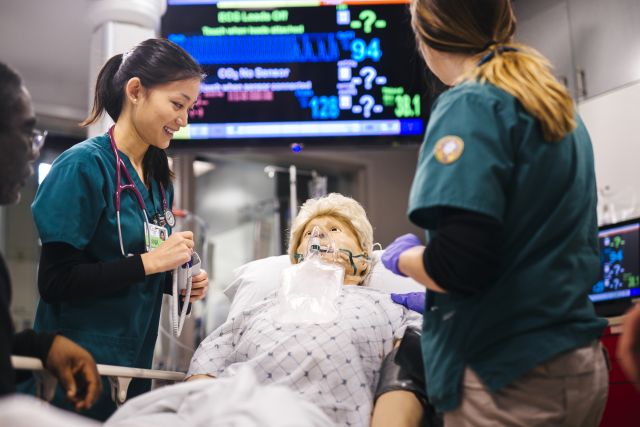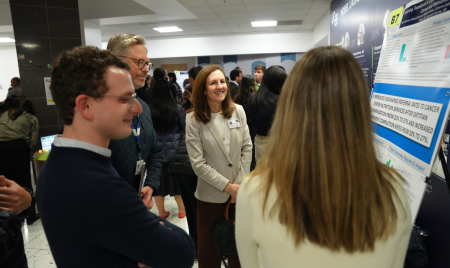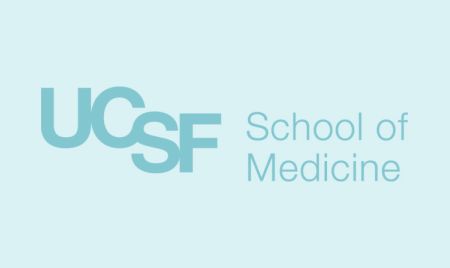Kanbar Center for Simulation and Clinical Skills Celebrates 10 Years

Students from the School of Nursing practice in the Kanbar Simulation Center. Photo by Anastasiia Sapon.
In 2011, after years of planning, a teaching and learning center opened on the second floor of the Kalmanovitz Library on the UCSF Parnassus campus. All of the health professions schools at UCSF helped design the facility and established programming, according to UCSF Associate Dean of Medical Education Kevin Souza. “People really wanted to work together to create something that was special for UCSF.”
Ten years later, the center continues to be a central place for learning and simulation for people from all five UCSF health professional schools and at all levels of training — from high school students to seasoned physicians. Activities at the center range from those that use actors (standardized patients), to activities with partial task trainers and mannequins.
Professor of Clinical Pediatrics Sandrijn van Schaik, MD, PhD who also serves as the Baum Family Presidential Chair for Experiential Learning and the Education Director of the Kanbar Center, understands first-hand the importance of simulation-based education since this was not part of her medical training.
Simulation can help you apply knowledge into practice. It gives you a muscle memory for actions that need to happen quickly.
Sandrijn van Schaik, MD, PhD
Professor, Pediatrics
“On my first night on call I was extremely nervous,” Dr. Van Schaik said. “My beeper went off and I ran into the labor room. There was a baby just born who wasn’t breathing. Even though I had read about what to do, I had never practiced, and froze up on the spot.”
The baby survived, but the experience left a lasting impression on Dr. van Schaik, and now she is working to advance simulation education at UCSF and beyond. “Simulation can help you apply knowledge into practice,” Dr. van Schaik said. “It gives you a muscle memory for actions that need to happen quickly.”
The pandemic has underscored the need for simulation, Dr. van Schaik said. “We were the first, and for a long time the only, educational center open for business during the pandemic,” she said. “There is no way to teach resuscitation over zoom and there are motor components you can’t do without being physically present. We took the stance that practice of life-saving procedures and activities was as essential as real patient care, so we all gowned up and masked up.”
Angel Fluet, a third-year medical student, describes how powerful simulation training had been for her. “I remember in one case we learned about psychiatric evaluations and depression,” Flu-et said. “There was a standardized patient having suicidal thoughts and the learners were moved to tears — it felt so heavy and so real, it was really powerful.”
The center has also evolved during the past 10 years to improve its work related to diversity, equity and inclusion. For example, the center aims to have actors playing patients who are racially diverse. Actors also undergo unconscious bias training to reduce the spread of stereotypes.
Assistant Professor of Internal Medicine and Baum Family Faculty Simulation Scholar Sneha Daya, MD, launched a pilot program this year to use simulation to interrupt microaggressions for learners. In 2020, she realized that learners (residents and students) are asking that supervising doctors be better allies in dealing with microaggressions from patients, providers and families. “This is something we, as supervising doctors, were never taught in medical school,” she said. Dr. Daya set up a year-long longitudinal curriculum to help train faculty leaders on how to be better allies and how to better manage and confront microaggressions in the learning environment. The training involves simulation with standardized patient actors. Dr. Daya is able to commit time to projects like this because of the Baum Family Faculty Simulation Scholarship, which allows the faculty scholars to use protected time to focus on simulation studies and experiential learning, as well as receive one-on-one guidance and mentorship on their projects directly from Dr. van Schaik and other simulation experts.
Dr. Daya believes simulation is an effective educational strategy, especially during COVID, be-cause it can enable the teaching of clinical skills in a virtual environment. Last year she adapted mannequin-based simulation curriculum to SimMon, a remote-controlled patient monitor. In one scenario, a patient would suddenly have low blood pressure so students would see the patient’s heart rate, oxygen levels and blood pressure. They could “administer” medications in this simulated environment and observe the impact it had on SimMon.
Simulation gives learners an ideal environment to get feedback, said Maria Wamsley, MD, who is the director for the UCSF Program for Interprofessional Practice and Education. Every year she leads a program that brings more than 600 people together at Kanbar including learners from dentistry, nursing, medicine, physical therapy, dietitians, and chaplains. At least 90 percent of health professional students at UCSF go through this program, Dr. Wamsley said. These groups are placed in inter-professional teams who meet a standardized patient and come up with a collaborative care plan. The learners debrief about what went well, and what they would change about working with an interprofessional team in the future. In 2021 the program was successfully brought to a virtual environment, but Dr. Wamsley hopes it will take place in person in the spring of 2022. “Students love it, faculty love it, it’s one of our programs that’s most highly valued because they get a chance to work together in the context of a patient case,” Dr. Wamsley said.
Looking forward to the next ten years, Dr. van Schaik expects that simulation education will change in health care settings to include more just-in-time training. “We’ll see a lot more simulation-based training in the places that health care happens as opposed to a separate simulation facility,” Dr. van Schaik said. “Let’s say you’re about to go in the operating room to do a procedure you haven’t done in a while. Ideally, you can practice in the OR or an adjacent room before the procedure.” This type of “in-situ” practice is now available to care teams at UCSF Benioff Children’s Hospital where teams run through emergency scenarios in actual patient care rooms to be prepared for real emergencies.
“In the next 10 years we are bound to see an expansion in simulation education,” Dr van Schaik said. Virtual and blended simulation will likely continue to see exponential growth. She also anticipates that more and more professions and specialties will require simulation prior to independent practice, and to maintain competency in practice.









